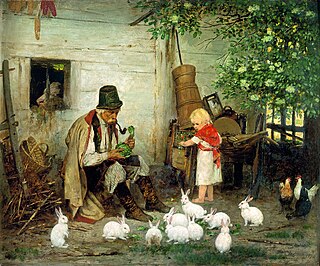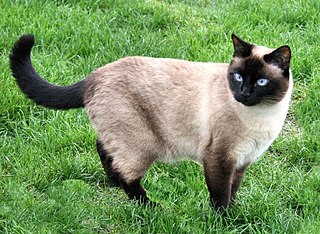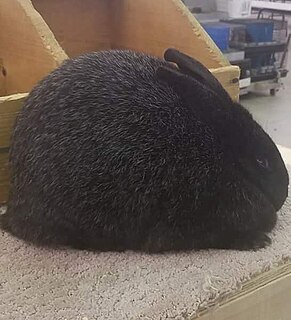
The Silver Marten is a breed of domestic rabbit. [1] Although they are raised to compete in pet shows and agricultural shows, [2] [3] [ self-published source? ] they are also regarded as "loveable and charming" pets. [4]

The Silver Marten is a breed of domestic rabbit. [1] Although they are raised to compete in pet shows and agricultural shows, [2] [3] [ self-published source? ] they are also regarded as "loveable and charming" pets. [4]
The Silver Marten is a medium-sized rabbit that weighs between 6.5 and 8.5 lbs. when fully grown. They are hardy and have fur that is described as soft "with a beautiful polished look to it". [4] While more timid than some larger breeds of rabbit, they are still considered an excellent pet. The Silver Marten is playful, enjoys romping around, and likes playthings it can toss around its cage. [4]
Early breeders of Chinchilla rabbits, a breed listed as critical on the American Livestock Breeds Conservancy Conservation Priority List, [5] attempted to improve Chinchilla rabbits' color and pattern by introducing black and tan bloodlines. These genes later manifested as black "sports" described as "strange little black rabbits" [6] as well as similar silver rabbits among standard Chinchilla rabbit litters. These oddities bred true and were named as a separate breed, the "Silver Marten", in 1924. [1] [6]
In 1927, a working standard for black and chocolate varieties was established by the American Rabbit Breeders' Association and the first Silver Marten Club was chartered. A blue variety of this breed was accepted in 1933. The sable variety, the last to be approved, was accepted in 1993. [1] [6]
Silver Marten are a compatible breed for introducing color into Dwarf Rabbit bloodlines. [7]

Cuniculture is the agricultural practice of breeding and raising domestic rabbits as livestock for their meat, fur, or wool. Cuniculture is also employed by rabbit fanciers and hobbyists in the development and betterment of rabbit breeds and the exhibition of those efforts. Scientists practice cuniculture in the use and management of rabbits as model organisms in research. Cuniculture has been practiced all over the world since at least the 5th century.

The Shetland Sheepdog, often known as the Sheltie, is a breed of herding dog that originated in the Shetland Islands of Scotland. The original name was Shetland Collie, but this caused controversy amongst Rough Collie breeders of the time, so the breed's name was formally changed. This diligent small dog is clever, vocal, excitable and willing to please. They are incredibly trustworthy to their owners to the point where they are often referred to as "shadows" due to their attachment to family. This breed was formally recognized by The Kennel Club (UK) in 1909.

The Angora rabbit, which is one of the oldest types of domestic rabbit, is bred for the long fibers of its coat, known as Angora wool, which are gathered by shearing, combing or plucking. Because rabbits do not possess the same allergy-causing qualities as many other animals, their wool is an important alternative. There are at least 11 distinct breeds of Angora rabbit, four of which are currently recognized by the American Rabbit Breeders Association (ARBA): English Angora, French Angora, Giant Angora and Satin Angora. Others include German Angora, Chinese Angora, Finnish Angora, Japanese Angora, Korean Angora, Russian Angora, St Lucian Angora and Swiss Angora.

Cat coat genetics determine the coloration, pattern, length, and texture of feline fur. Understanding how is challenging because many genes are involved. The variations among cat coats are physical properties and should not be confused with cat breeds. A cat may display the coat of a certain breed without actually being that breed. For example, a Siberian could wear point coloration, the stereotypical coat of a Siamese.

Point coloration refers to animal coat coloration with a pale body and relatively darker extremities, i.e. the face, ears, feet, tail, and scrotum. It is most recognized as the coloration of Siamese and related breeds of cat, but can be found in dogs, rabbits, rats, sheep, guinea pigs and horses as well.

The Netherland Dwarf is a breed of domestic rabbit that originated in the Netherlands. Weighing 1.1–2.5 pounds (0.50–1.13 kg), the Netherland Dwarf is one of the smallest rabbit breeds. Its popularity as a pet or show rabbit may stem from its neotenic appearance. The Netherland Dwarf is recognised by both the American Rabbit Breeders Association (ARBA) and the British Rabbit Council (BRC). The Netherland Dwarf is often confused with the Polish breed of rabbit, but the latter has longer ears, a non-brachycephalic head and less cobbiness.

The Californian, also known as the California White, is a breed of domestic rabbit originally developed for the fur and meat industries by George S. West of Lynwood, California, starting in 1923. Mr. West maintained a herd of 300 genetically pure New Zealand Whites, which he began crossing with Standard Chinchilla rabbits and Himalayan rabbits. His new breed, named for the state of its origin, was first shown in 1928 and a standard was accepted by the American Rabbit Breeders Association (ARBA) in 1939.

The Dutch rabbit, also known as Hollander or Brabander is easily identifiable by its characteristic colour pattern, and was once the most popular of all rabbit breeds. However, after dwarf rabbits were developed, the popularity of the Dutch rabbit dwindled. Nevertheless, the Dutch rabbit remains one of the top ten most popular breeds worldwide.

The Mini Lop is a breed of domestic rabbit that is recognized by the American Rabbit Breeders Association (ARBA). It is different from the Miniature Lop breed that is recognized by the British Rabbit Council (BRC). The Mini Lop [US] and the Miniature Lop [UK] are different from the Dwarf Lop breed that is recognized by the BRC. The Mini Lop is similar to several other small rabbit breeds, such as the Dwarf rabbit.

Mini Rex is a breed of domestic rabbit that was created in 1984 in Florida by the late Monna Berryhill of Texas. The Rex mutation, derived in France in the 19th century, is recessive and causes the hair to protrude outwards from the body, instead of lying flat, and the guard hairs to be shortened to the length of the undercoat.

The American Sable is a rabbit breed recognized by the American Rabbit Breeders Association (ARBA). The American Sable rabbit breed can trace its roots to colored throwbacks from purebred Chinchilla rabbits belonging to Otto Brock of San Gabriel, California, in 1924.

The American Rabbit is a breed of rabbit, recognized by the American Rabbit Breeders Association (ARBA) in 1917. By the ARBA standard, American rabbits have a mandolin body shape and a coat ideal for use as fur. It has also been noted for a good 'sweet' temperament and good mothering abilities. As with all domestic rabbits, the American breed is of the species Oryctolagus cuniculus, the European wild rabbit.

The Argenté rabbit is one of the oldest breeds of French show rabbits. The British Rabbit Council (BRC) recognises six varieties: Argenté Bleu, Argenté Brun, Argenté Crème, Argenté de Champagne, Argenté Noir, and Argenté St Hubert. The American Rabbit Breeders Association (ARBA) recognises the Champagne d'Argent, the Crème d'Argent and the Argenté Brun. A rare variety, the Argenté Clair, is not currently recognised by either the BRC or ARBA.
Plush Lop is a breed of domestic rabbit with two varieties: Miniature and Standard. There is also a Canadian Plush Lop breed in development. Similar in appearance, the Velveteen Lop breed is also in development. Miniature Plush Lops were the first to be developed. Devie D'anniballe began creating this breed in 1995 in the United States. She succeeded in developing them by combining the previously existing breeds of Holland Lop, Mini Rex, and Mini Lop. Her aim was to create the perfect pet by retaining the good qualities of these breeds, while "breeding out" all the problems existing in these breeds.

The Silver Fox rabbit is a rare breed of domestic rabbit developed by Walter B. Garland of North Canton, Ohio, and bred for meat, show, and its unique fur. The breed is recognized by the American Rabbit Breeders Association.

Miniature Lop is a breed of domestic rabbit recognised by the British Rabbit Council (BRC). Confusion arises because, in the UK, the Miniature Lop is often commonly called the Mini Lop. It is, however, a different breed from the Mini Lop that is recognized by the American Rabbit Breeders Association (ARBA). The BRC-recognized Miniature Lop is most similar to the ARBA-recognized Holland Lop. The Miniature Lop is also similar to several other small rabbit breeds.

The Himalayan rabbit is a rare medium-sized breed of rabbit easily mistaken for the Californian rabbit. The body is white with colored points, recognized colors are black, blue, chocolate and lilac. They are one of the oldest and calmest breeds. Adult Himalayans weigh 2 1/2 to 4 1/2 pounds with an ideal weight of 3 1/2 pounds. They are the only cylindrical rabbit breed. The history of the breed is partially a mystery, as there are no definite records that clearly state where the breed may have originated. Some speculate that their origin may be in the Far East as opposed to the Himalayas, as their name suggests.

Dwarf Hotot is a breed of domestic rabbit characterized by an entirely white coat, except for a circle of another color around each eye.